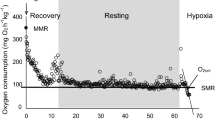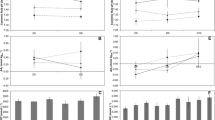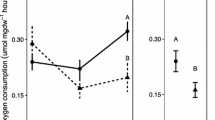Abstract
Ocean acidification (OA) caused by excessive CO2 is a potential ecological threat to marine organisms. The impacts of OA on echinoderms are well-documented, but there has been a strong bias towards sea urchins, and limited information is available on sea cucumbers. This work examined the effect of medium-term (60 days) exposure to three pH levels (pH 8.06, 7.72, and 7.41, covering present and future pH variability) on the bioenergetic responses of the sea cucumber, Apostichopus japonicus, an ecologically and economically important holothurian in Asian coasts. Results showed that the measured specific growth rate linearly decreased with decreased pH, leading to a 0.42 %·day−1 decrease at pH 7.41 compared with that at pH 8.06. The impacts of pH on physiological energetics were variable: measured energy consumption and defecation rates linearly decreased with decreased pH, whereas maintenance energy in calculated respiration and excretion were not significantly affected. No shift in energy allocation pattern was observed in A. japonicus upon exposure to pH 7.72 compared with pH 8.06. However, a significant shift in energy budget occurred upon exposure to pH 7.41, leading to decreased energy intake and increased percentage of energy that was lost in feces, thereby resulting in a significantly lowered allocation into somatic growth. These findings indicate that adult A. japonicus is resilient to the OA scenario at the end of the twenty-first century, but further acidification may negatively influence the grazing capability and growth, thereby influencing its ecological functioning as an “ecosystem engineer” and potentially harming its culture output.


Similar content being viewed by others
References
AOAC (Association of Official Analytical Chemists) (1990) Official methods of analysis. In: Helrich K (ed), 15th edn. Arlington, Virginia, p 1298
Appelhans YS, Thomsen J, Pansch C, Melzner F, Wahl M (2012) Sour times: seawater acidification effects on growth, feeding behavior and acid-base status of Asterias nubens and Carcinus maenas. Mar Ecol Prog Ser 459:85–97
Byrne M, Ho M, Wong E, Soars NA, Selvakumaraswamy P, Brennand HS, Dworjanyn SA, Davis A (2011) Unshelled abalone and corrupted urchins: development of marine calcifiers in a changing ocean. Proc R Sco Lond B Biol Sci 278:2376–2383
Catarino AI, Bauwens M, Dubois P (2012) Acid-base behavior and metabolic response of the sea urchin Paracentrotus lividus to different seawater pH and temperatures. Eviron Sci Pollut Res 19:2344–2353
CFSY (China Fishery Statistical Yearbook) (2014) China fishery statistical yearbook. China Agriculture Publishing Press, Beijing, China (in Chinese)
Chen J (2004) Present status and prospects of sea cucumber industry in China. In: Mercier A, Lovatelli A, Conand C, Purcell S, Uthicke S, Hamel J–F (eds) Advances in sea cucumber aquaculture and management. FAO, Rome, pp 25–38
Christensen AB, Nguyen HD, Byrne M (2011) Thermotolerance and the effects of hypercapnia on the metabolic rate of the ophiuroid Ophionereis schayeri: inferences for survivorship in a changing ocean. J Exp Mar Biol Ecol 403:31–38
Clarkson MO, Kasemann SA, Wood RA, Lenton TM, Daines SJ, Richoz S, Ohnemueller F, Meixner A, Poulton SW, Tipper ET (2015) Ocean acidification and the Permo-Triassic mass extinction. Science 348(6231):229–232
Collard M, Laitat K, Moulin L, Catarino AI, Grosjean P, Dubois P (2013) Buffer capacity of the coelomic fluid in echinoderms. Comp Biochem Physiol A Mol integr Physiol 166(1):199–206
Collard M, Eeckhaut I, Dehairs F, Dubois P (2014) Acid–base physiology response to ocean acidification of two ecologically and economically important holothuroids from contrasting habitats, Holothuria scabra and Holothuria parva. Eviron Sci Pollut Res 21(23):13602–13614
Dorey N, Lançon P, Thorndyke M, Dupont S (2013) Assessing physiological tipping point of sea urchin larvae exposed to a broad range of pH. Glob Chang Biol 19(11):3355–3367
Dupont S, Pörtner H-O (2013) Get ready for ocean acidification. Nature 498:429
Dupont S, Thorndyke M (2014) Direct impacts of near-future ocean acidification on sea urchins. In: Fernández-Palacios JM, de Nascimento L, Hernández JC, Clemente S, González A, Díaz-González JP (eds) Climate change perspective from the Atlantic: past, present and future. Servicio de Publicaciones, Universidad de La Laguna, pp 461–485
Dupont S, Ortega-Martınez O, Thorndyke M (2010) Impact of near-future ocean acidification on echinoderms. Ecotoxicology 19:449–462
Fabry VJ, Seibel BA, Feely RA, Orr JC (2008) Impacts of ocean acidification on marine fauna and ecosystem processes. ICES J Mar Sci 65:414–432
Gooding RA, Harley DG, Tang E (2009) Elevated water temperature and carbon dioxide concentration increase the growth of a keystone echinoderm. Proc Natl Acad Sci 106:9316–9321
Hall-Spencer JM, Rodolfo-Metalpa R, Martin S, Ransome E, Fine M, Turner SM, Rowley SJ, Tedesco D, Buia MC (2008) Volcanic carbon dioxide vents show ecosystem effects of ocean acidification. Nature 454:96–99
IPCC (2013) Climate change 2013: the physical science basis. In: Stocker et al (eds) Contribution of working group I to the fifth assessment report of the intergovernmental panel on climate change. Cambridge University Press, Cambridge
Knoll AH, Bamback RK, Payne JL, Pruss S, Fischer WW (2007) Paleophysiology and end-Permian mass extinction. Earth Planet Sci Lett 256:295–313
Kreiss CM, Michael K, Lucassen M, Jutfelt F, Motyka R, Dupont S, Pörtner H-O (2015) Ocean warming and acidification modulate energy budget and gill ion regulatory mechanisms in Atlantic cod (Gadus morhua). J Comp Physiol B 185(7):1–15
Kurihara H, Yin R, Nishihara GN, Soyano K, Ishimatsu A (2013) Effect of ocean acidification on growth, gonad development and physiology of the sea urchin Hemicentrotus pulcherrimus. Aquat Biol 18:281–292
Lawrence JM (1984) The energetic echinoderm. In: Proceedings of the fifth international Echinoderm Conference. A A Balkema Publishers, Rotterdam, pp 47–67
Lewis E, Wallace DWR (1998) Program developed for CO2 system calculations. ORNL/CDIAC-105. Carbon Dioxide Information Analysis Center, Oak Ridge National Laboratory, U.S. Department of Energy, Oak Ridge
Liao YL (1997) Fauna sinica, Phylum echinodermata, class Holothuroidea. Science Press, Beijing, 334 pp (in Chinese)
McElroy DJ, Nguyen HD, Byrne M (2012) Respiratory response of the intertidal seastar Parvulastra exigua to contemporary and near-future pulses of warming and hypercapnia. J Exp Mar Biol Ecol 416–417:1–7
Melzer F, Gutowska CH, Langenbuch M, Dupont S, Lucassen M, Thorndyke MC, Bleich M, Pörtner H-O (2009) Physiological basis for high CO2 tolerance in marine ectothermic animals: pre-adaptation through lifestyle and ontogeny? Biogeosciences 6:2313–2331
Micael J, Alves MJ, Costa AC, Jones MB (2009) Exploitation and conservation of echinoderms. Oceanogr Mar Biol 47:191–208
Morita M, Suwa R, Iguchi A, Nakamura M, Shimada K, Sakai K, Suzuki A (2009) Ocean acidification reduces sperm flagellar motility in broadcast spawning reef invertebrates. Zygote 18:103–107
Moulin L, Grosjean P, Leblud J, Batigny A, Dubois P (2014) Impact of elevated pCO2 on acid–base regulation of the sea urchin Echinometra mathaei and its relation to resistance to ocean acidification: a study in mesocosms. J Exp Mar Biol Ecol 457:97–104
Moulin L, Grosjean P, Leblud J, Batigny A, Collard M, Dubois P (2015) Long-term mesocosms study of the effects of ocean acidification on growth and physiology of the sea urchin Echinometra mathaei. Mar Environ Res 103:103–114
Murray F, Widdicombe S, McNeill L, Solan M (2013) Consequences of a simulated rapid ocean acidification event for benthic ecosystem process and functions. Mar Pollut Bull 73:435–442
Navarro JM, Torres R, Acuña K, Duarte C, Manriquez PH, Lardies M, Lagos N, Vargas C, Aguilera V (2013) Impacts of medium-term exposure to elevated pCO2 levels on the physiological energetics of the mussel Mytilus chilensis. Chemosphere 90:1242–1248
Pan F, Applebaum SL, Sawyer RJ, Manahan DT (2014) Ocean acidification alters energy allocation in developing sea urchins. Integr Comp Biol 54:E159–E159
Pörtner HO (2008) Ecosystem effects of ocean acidification in times of ocean warming: a physiologist’s view. Mar Ecol Prog Ser 373:203–217
Schneider K, Silverman J, Woolsey E, Eriksson H, Byrne M, Caldeira K (2011) Potential influence of sea cucumbers on coral reef CaCO3 budget: a case study at one tree reef. J Geophys Res 116:G04032
Shirayama Y, Thornton H (2005) Effect of increased atmospheric CO2 on shallow water marine benthos. J Geophys Res 110:108–115
Siikavuopio SI, Mortensen A, Dale T, Foss A (2007) Effects of carbon dioxide exposure on feeding intake and gonad growth in green sea urchin, Strongylocentrotus droebachiensis. Aquaculture 266:97–101
Stumpp M, Wren J, Melzner F, Thorndyke MC, Dupont S (2011) CO2 induced seawater acidification impacts sea urchin larval development I: elevated metabolic rates decrease scope for growth and induce developmental delay. Comp Biochem Physiol A Mol integr Physiol 160:331–340
Stumpp M, Trübenbach K, Brennecke D, Melzner F (2012) Resource allocation and extracellular acid–base status in the sea urchin Strongylocentrotus droebachiensis in response to CO2 induced seawater acidification. Aquat Toxicol 110–111:194–207
Sun J, Zhang L, Pan Y, Lin C, Wang F, Kan R, Yang H (2015) Feeding behavior and digestive physiology in sea cucumber Apostichopus japonicus. Physiol Behav 139:336–343
Taylor JR, Lovera C, Whaling PJ, Buck KR, Pane EF, Barry JP (2014) Physiological effects of environmental acidification in the deep-sea urchin Strongylocentrotus fragilis. Biogeosciences 11(5):1413–1423
Uthicke S (2001) Nutrient regeneration by abundant coral reef holothurians. J Exp Mar Biol Ecol 265(2):153–170
Uthicke S, Soars N, Foo S, Byrne M (2013) Effects of elevated pCO2 and the effect of parent acclimation on development in the tropical Pacific sea urchin Echinometra mathaei. Mar Biol 160(8):1913–1926
Wang GN, Yagi M, Yin R, Lu WQ, Ishimatsu A (2013) Effects of elevated seawater CO2 on feed intake, oxygen consumption and morphology of Aristotle’s lantern in the Sea urchin anthocidaris crassispina. J Mar Sci Tech 21:192–200
Widdicombe S, Spicer JL (2008) Predicting the impact of ocean acidification on benthic biodiversity: what can animal physiology tell us? J Exp Mar Biol Ecol 366(1–2):187–197
Wood HL, Spicer JI, Lowe DM, Widdicombe S (2010) Interaction of ocean acidification and temperature: the high cost of survival in the brittlestar Ophiura ophiura. Mar Biol 157:2001–2013
Wood HL, Spicer JI, Kendall MA, Lowe DM, Widdicombe S (2011) Ocean warming and acidification: implications for the Arctic brittlestar Ophiocten sericeum. Polar Biol 34:1033–1044
Yang H, Hamel J-F, Mercier A (2015) The sea cucumber Apostichopus japonicus: history, biology and aquaculture. Academic Press (Elsevier), Utah, p 437
Yuan X, Yang H, Wang L, Zhou Y, Gabr HR (2009) Bioenergetic responses of sub-adult sea cucumber Apostichopus japonicus (Selenka) (Echinodermata: Holothuroidea) to temperature with special discussion regarding its southernmost distribution limit in China. J Therm Biol 34(6):315–319
Yuan X, Yang H, Meng L, Wang L, Li Y (2013) Impacts of temperature on the scavenging efficiency by the deposit-feeding holothurian Apostichopus japonicus on a simulated organic pollutant in the bivalve macroalage co-culture from the perspective of nutrient budgets. Aquaculture 406:97–104
Yuan X, Meng L, Wang L, Zhao S, Li H (2014) Responses of scallop biodeposits to bioturbation by a deposit-feeder Apostichopus japonicus (Echinodermata: Holothuroidea): does the holothurian density matter? Aquac Res. doi:10.1111/are.12511
Yuan X, Shao S, Dupont S, Meng L, Liu Y, Wang L (2015a) Impact of CO2-driven acidification on the development of the sea cucumber Apostichopus japonicus (Selenka) (Echinodermata: Holothuroidea). Mar Pollut Bull 95(1):195–199
Yuan X, Zhou Y, Mao Y (2015b) Apostichopus japonicus: a key species in integrated polyculture systems. In: Yang H, Hamel J-F, Mercier A (eds) The Sea Cucumber Apostichopus japonicus. History, Biology and Aquaculture, Academic Press (Elsevier), Utah, pp 323–332
Zhai W, Zheng N, Huo C, Xu Y, Zhao H, Li Y, Zang K, Wang J, Xu X (2014) Subsurface pH and carbonate saturation state of aragonite on the Chinese side of the North Yellow Sea: seasonal variations and controls. Biogeosciences 11:1103–1123
Acknowledgments
This study was funded by the National Natural Science Foundation of China (no. 30871932), National Marine Public Welfare Research Project (no. 201305043), Foundation from Key Laboratory of Marine Spill Oil Identification and Damage Assessment Technology, SOA (2014-09), and China Scholarship Council (no. 201404180009). We particularly thank several anonymous referees for professional comments on this manuscript.
Author information
Authors and Affiliations
Corresponding author
Additional information
Responsible editor: Philippe Garrigues
Electronic supplementary material
Below is the link to the electronic supplementary material.
ESM 1
(DOCX 85 kb)
Rights and permissions
About this article
Cite this article
Yuan, X., Shao, S., Yang, X. et al. Bioenergetic trade-offs in the sea cucumber Apostichopus japonicus (Echinodermata: Holothuroidea) in response to CO2-driven ocean acidification. Environ Sci Pollut Res 23, 8453–8461 (2016). https://doi.org/10.1007/s11356-016-6071-0
Received:
Accepted:
Published:
Issue Date:
DOI: https://doi.org/10.1007/s11356-016-6071-0




